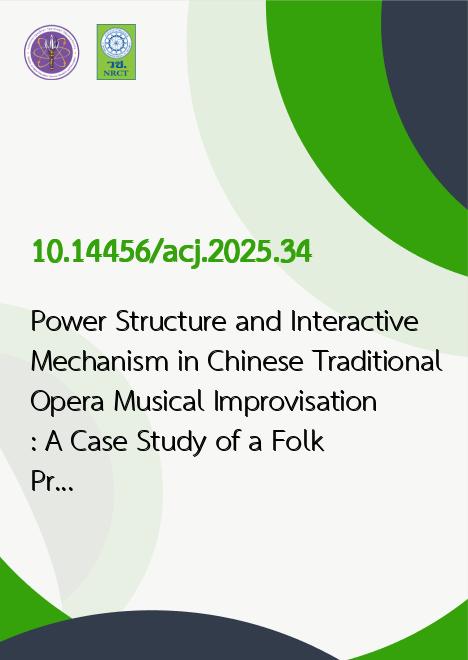
|
Power Structure and Interactive Mechanism in Chinese Traditional Opera Musical Improvisation : A Case Study of a Folk Professional Wuju Opera Troupe |
|---|---|
| รหัสดีโอไอ | |
| Creator | Lu Huang |
| Title | Power Structure and Interactive Mechanism in Chinese Traditional Opera Musical Improvisation : A Case Study of a Folk Professional Wuju Opera Troupe |
| Contributor | Nataporn Rattanachaiwong |
| Publisher | The Office of Arts and Culture, Surindra Rajabhat University |
| Publication Year | 2568 |
| Journal Title | Arts and Culture Journal of the Lower Moon River |
| Journal Vol. | 14 |
| Journal No. | 2 |
| Page no. | 462-475 |
| Keyword | Cultural Inheritance, Instrumental Improvisation, Interactive Mechanism, Power Structure, Wuju Opera |
| URL Website | https://so07.tci-thaijo.org/index.php/acj |
| Website title | วารสารศิลปะและวัฒนธรรมลุ่มแม่น้ำมูล |
| ISSN | ISSN 2822 - 0617 (Online);ISSN 2822 - 1141 (Print) |
| Abstract | This research focuses on instrumental music improvisation in Chinese traditional opera, studying a folk professional Wuju Opera troupe in Jinhua, Zhejiang, to explore its power structure and interactive mechanisms in instrumental improvisation. The study addresses the critical issue of preserving traditional opera art forms in modern society, where mechanisms for “living inheritance” remain insufficiently understood. Based on performance theory and oral-formulaic theory perspectives, through a 12-month ethnographic study involving participatory observation of 54 performances and 32 rehearsals, and interviews with 10 core musicians, the research finds that Wuju Opera instrumental improvisation is built upon a hierarchical power structure of “Five Principal Positions,” forming a dual interactive system of vertical command and horizontal coordination. Its operation follows a “cue-response-feedback” cyclical mechanism, transmitting information through three types of cues, achieving collaboration through hierarchical responses, and ensuring artistic effect through dynamic feedback. Wuju Opera instrumental improvisation embodies dialectical characteristics of “formula-dominated flexible adaptation,” with power regulations and creative freedom balanced through layered authorization, tacit boundaries, and feedback adjustments. The research enriches the interactive analysis framework of performance theory, expands the application scope of oral-formulaic theory, proposes a multi-dimensional identity construction model of “sound-practice-emotion,” and provides new perspectives for the protection and inheritance of traditional opera. |